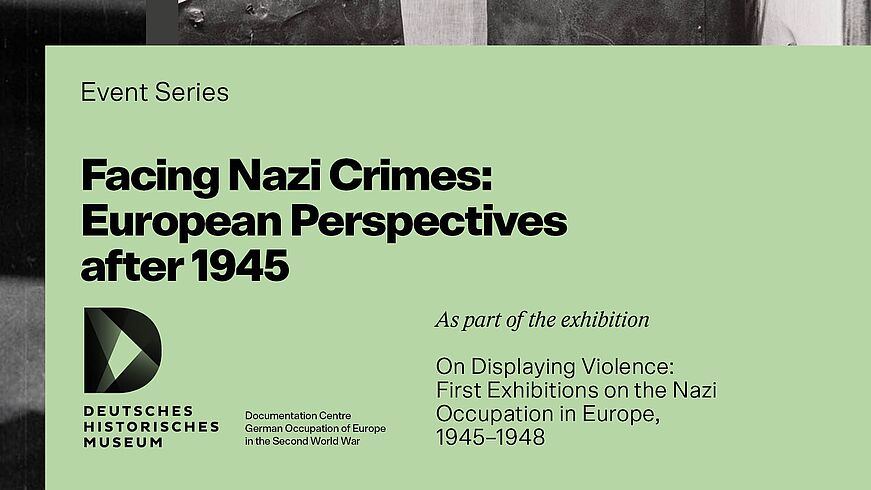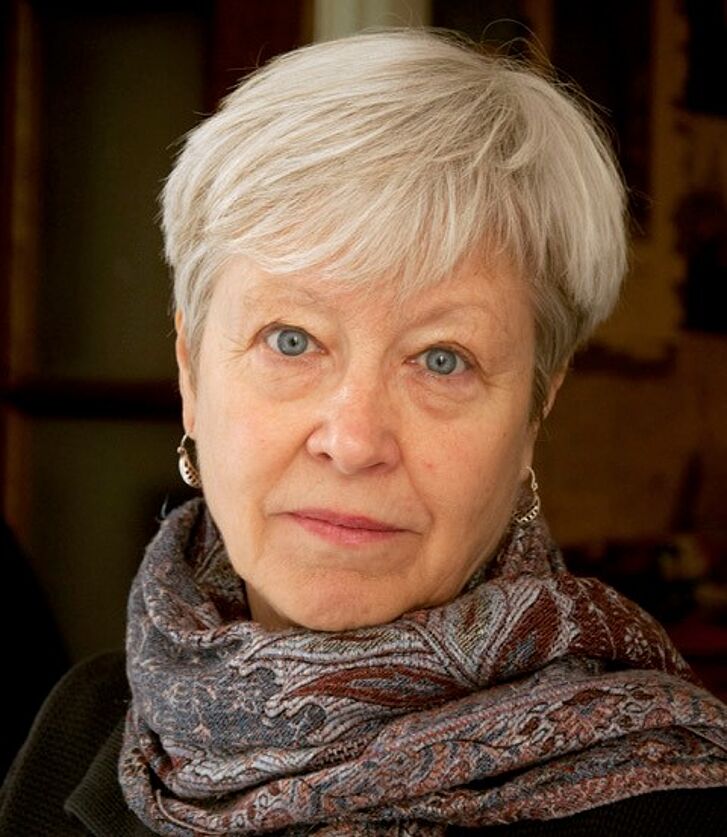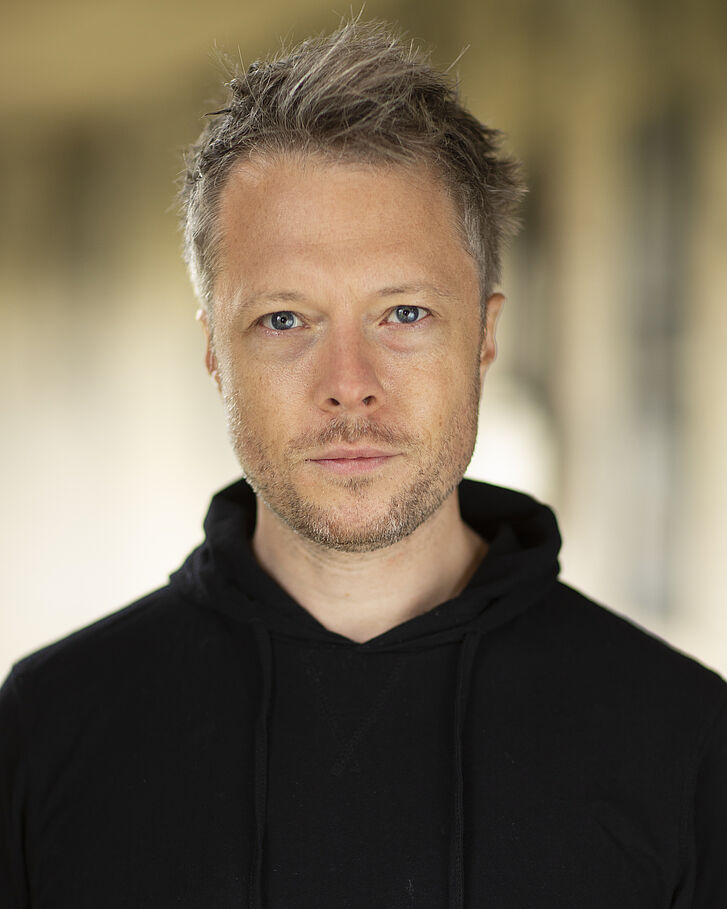Facing Nazi Crimes: European Perspectives after 1945
European Event Series on the exhibition “On Displaying Violence: First Exhibitions on the Nazi Occupation in Europe, 1945–1948”
Starting on 13 May 2025 in the German Historical Institute London
Download
To accompany the upcoming exhibition “On Displaying Violence: First Exhibitions on the Nazi Occupation in Europe, 1945–1948”, the Deutsches Historisches Museum extends an invitation to attend the European event series “Facing Nazi Crimes: European Perspectives after 1945”, which takes place from May to October 2025. Developed jointly by the DHM and the Documentation Centre “German Occupation of Europe in the Second World War”, the series is devoted to the social and historical circumstances surrounding the first post-war exhibitions about the Nazi occupation, which were held between 1945 and 1948 in Paris, Warsaw,
London, Liberec and Bergen-Belsen. The series will be held at these locations and will conclude in Berlin.
At the events, international guests and members of the exhibition team will explore the relationship of the exhibitions to the early documentary, legal, political and historical deliberations about the German occupation and crimes committed at the time. How were the exhibitions received and what influence did they have on the still ongoing culture of remembrance? On six evenings, central aspects of the early exhibitions, how they came about, and what effect they had will be discussed with experts on the topic. The admission-free event series will be streamed online and subsequently accessible on the DHM website.
The first event takes place on Tuesday, 13 May 2025, in cooperation with the German Historical Institute London and the Institute of Historical Research, University of London. The exhibition “The Horror Camps”, which opened in May 1945 in the reading room of the Daily Express in London, showed enlarged photographs from liberated Nazi camps. Questions about the relationship between image and evidence and the public use of degrading images are still profoundly relevant today. The photographer and author Janina Struk, the historian Paul Betts and the curator James Bulgin will discuss these questions in reference to changing historical conditions and curatorial practices.
All dates and venues of the event series “Facing Nazi Crimes: European Perspectives after 1945”:
London – Images as Evidence
Tuesday, 13 May 2025, 5.30 pm GMT, 6.30 pm CET, German Historical Institute London
In cooperation with the German Historical Institute London and the Institute of Historical Research, University of London
With Janina Struk, Paul Betts and James Bulgin
Starting in May 1945, the exhibition “The Horror Camps”, displayed in the Reading Room of the Daily Express in London, featured enlarged photographs from the liberated Nazi camps. It prompted questions about the relationship between image and evidence, as well as the public use of degrading images, which remain profoundly relevant to this day. These questions will be discussed against the backdrop of changing historical conditions and curatorial practices.
English with German interpretation
Paris – Scénographie et Narration | Scenography and Narration
Tuesday, 17 June 2025, 6.30 pm, German Center for Art History Paris
In cooperation with the German Center for Art History Paris and the German Historical Institute Paris
With Jean-Marc Dreyfus, Rachel E. Perry and others
The travelling exhibition “Crimes hitlériens” was first presented on 10 June 1945 in the Grand Palais in Paris. It marked one of the first attempts to portray the suffering under German occupation from a European perspective, employing an elaborate scenography to tell this story. The discussion revolves around the genesis and impact of the narration and staging strategies used in “Crimes hitlériens”.
French with German interpretation
Liberec – Pachatelé a odplata | Perpetrators and Retribution
Tuesday, 24 June 2025, 5 pm, North Bohemian Museum in Liberec
In cooperation with the North Bohemian Museum in Liberec and the German Historical Institute Warsaw, Prague branch office
With Kateřina Králová, Ivan Rous, Michal Stehlík and Jaromír Mrňka
The memorial site “Památník nacistického barbarství” (Memorial to Nazi Barbarism) was inaugurated on 8 September 1946 in a villa in the northern Bohemian city of Liberec. The villa, which had belonged to a Jewish entrepreneur until 1938, served as the residence of Nazi Gauleiter Konrad Henlein until the end of the war. The opening of the exhibition coincided with the expulsion of the German minority from Czechoslovakia. How did the regional and national narratives about the German occupation change over time, and what challenges did this bring for exhibitions today?
Czech with German interpretation
Warsaw – Pokłosie zniszczeń | Aftermath of Destruction
Thursday, 4 September 2025, 6 pm, POLIN Museum of the History of Polish Jews
In cooperation with the German Historical Institute Warsaw, the Jewish Historical Institute and the POLIN Museum of the History of Polish Jews
With Magdalena Saryusz-Wolska, Zuzanna Schnepf-Kołacz and others
In the politically unstable climate of the post-war period, two exhibitions – “Warszawa oskarża” (Warsaw Accuses) and “Martirologye un kamf / Martyrologia i walka” (Martyrology and Struggle) – were organised that shed light on the conflicting motives of the curators. With respect to the distinct perspectives of a Central European country that was a major site of the Holocaust and other German mass crimes, the question arises as to how the early controversial positions have continued to affect current discussions.
Polish with German interpretation
Bergen-Belsen – Survivors and Remembrance
Monday, 15 September 2025, 5.30 pm, Bergen-Belsen Memorial
In cooperation with the Bergen-Belsen Memorial
With Dan Michman, Elke Gryglewski and others
In 1947, survivors in the Bergen-Belsen Displaced Persons Camp organised the exhibition “Undzer veg in der frayhayt” (Our Path to Freedom). It provides remarkable insight into how the history of the Nazi occupation and the Holocaust was told from the viewpoint of Jewish DPs. What importance did the perspectives of the victims have for historiography and the culture of remembrance then and now?
English with German interpretation
Berlin – European Memory?
Wednesday, 8 October 2025, 6.30 pm, Deutsches Historisches Museum
With Ljiljana Radonić and others
The first exhibitions about Nazi crimes were part of a Europe-wide phenomenon that came to a halt with the onset of the Cold War. To what extent can an examination of the discussions and confrontations of the post-war period be instructive for today’s culture of remembrance? What opportunities and challenges are connected with a project of European remembrance for an understanding of past and present?
In German
The event series takes place in cooperation with the Max Weber Foundation.
Admission is free to all events
Information about registration under dhm.de/programme
A video recording of the entire event series will subsequently be available on the DHM website and can also be heard on the DHM-Soundcloud-Channel and the DHM-Spotify-Channel.
“On Displaying Violence: First Exhibitions on the Nazi Occupation in Europe, 1945–1948”
At the height of its power, National Socialist Germany ruled over almost all of Europe. Some 230 million people in what are now 30 countries lived under German occupation. How did the postwar societies process their experiences of violence and destruction resulting from the Second World War and the concurrent Nazi occupation? A previously overlooked but historically influential form of coming to terms with this desolation are the exhibitions that were organised throughout Europe immediately after the war. In times of social hardship, political instability, enduring violence, and uncertain future, they aimed to document and visualise the consequences of the Holocaust and the Nazi crimes. With “On Displaying Violence: First Exhibitions on the Nazi Occupation in Europe, 1945–1948”
(24 May–23 November 2025), the Deutsches Historisches Museum traces for the first time the history of this pan-European phenomenon, using the examples of early exhibitions in London, Paris, Warsaw, Liberec and Bergen-Belsen. The DHM exhibition is presented in cooperation with the Documentation Centre “German Occupation of Europe in the Second World War”. It is the view of the project that a joint European remembrance, and thus a joint European future, depends to a great degree on the shared knowledge of the history of the German occupation.
The exhibition focuses on the different forms and presentations with which the exhibition organisers – most of them victims of Nazi persecution and Holocaust survivors – took up the themes of violence, resistance and perpetrators, as well as the loss of cultural heritage. This throws light on the different ideas about the future that were reflected in the early exhibitions. Rooted in the respective local and national contexts, the different visual languages of the time are analysed and the sources compared. The motivation of the participants and the effect of the exhibitions are examined, some of which travelled throughout Europe. Original objects, photographs, films, documents, artworks and multimedia presentations give the visitors a greater understanding of the challenges and backgrounds of this “first look back.”
Documentation Centre “Second World War and German Occupation in Europe”
Between 1939 and 1945, Germany brought disfranchisement, suffering, destruction and death to large parts of Europe. The methods of warfare and the treatment of the civilian population constituted major crimes. The Shoah and the genocide of Sinti and Roma were unique in history. In the areas that suffered under German occupation, the violence is still felt today. To acknowledge this, the German Bundestag resolved to found a Documentation Centre in Berlin and entrusted the DHM with its realisation. The future centre will present the European dimension of the German occupation and provide room for commemoration. It will focus on the experience of the victims, particularly those groups that have received less attention.
Further information on the Documentation Centre under: dhm.de/zwbe/
Press conference on the opening of the exhibition: Wednesday, 21 May 2025,
11 am, Deutsches Historisches Museum, Pei Building; registration via https://www.dhm.de/en/accreditation-for-the-press-conference-on-displaying-violence/
Press accreditation Event Series: Please contact the press office at the relevant location of the event.
Press photos: Initial pictures are available in the press section of the DHM website.
Update: Number of countries under German occupation

Accompanying programme “On Displaying Violence: First Exhibitions on the Nazi Occupation in Europe, 1945–1948”
© Grafik VISUAL SPACE AGENCY & STUDIO BENS

Janina Struk
© Janina Struk

Paul Betts
© Anna Betts

James Bulgin
© Steve Lawton